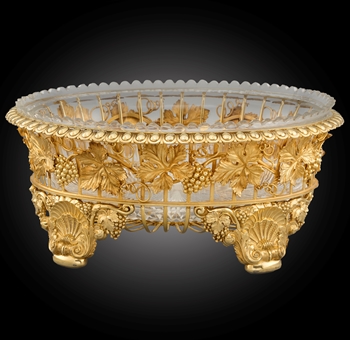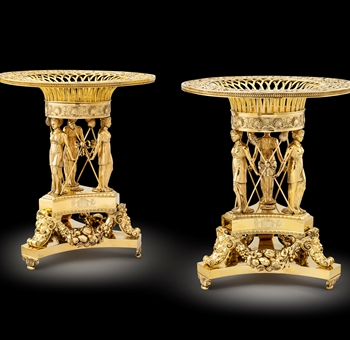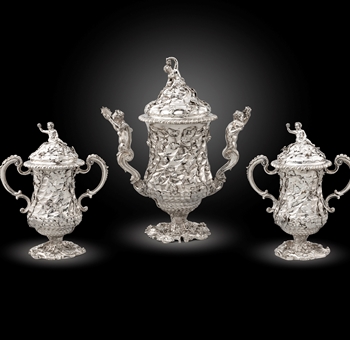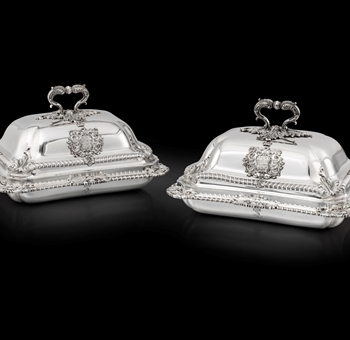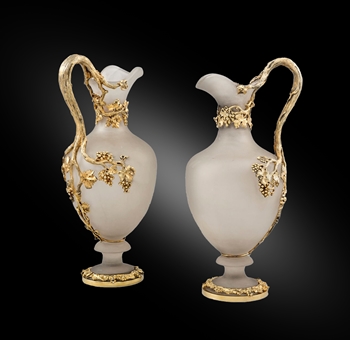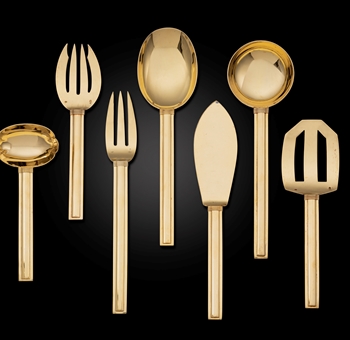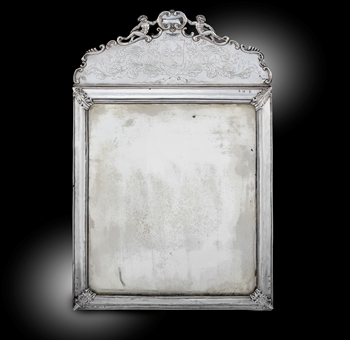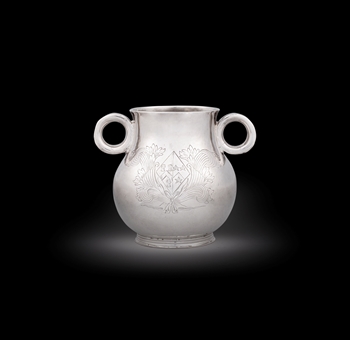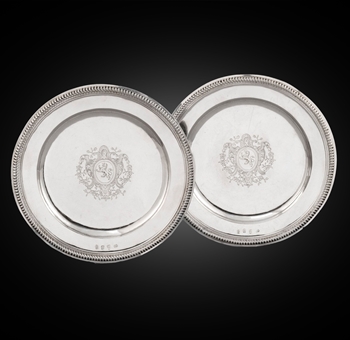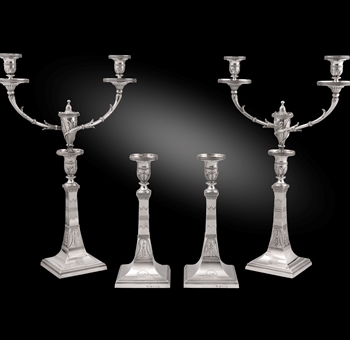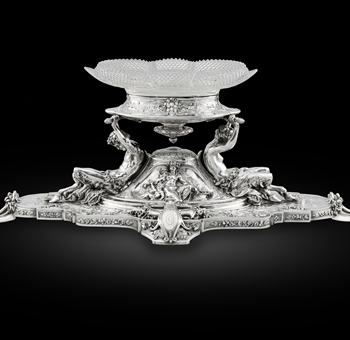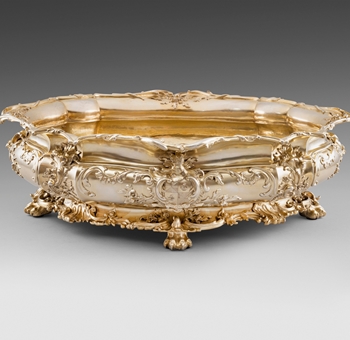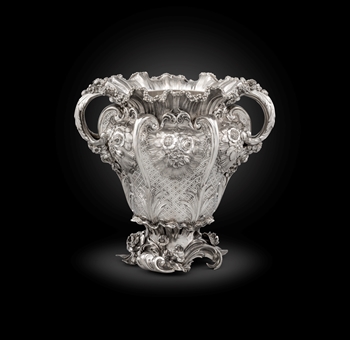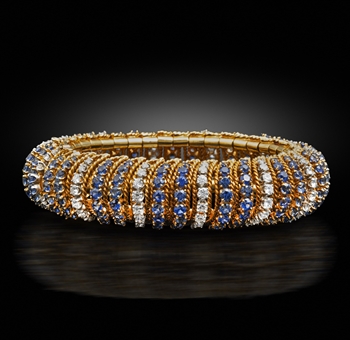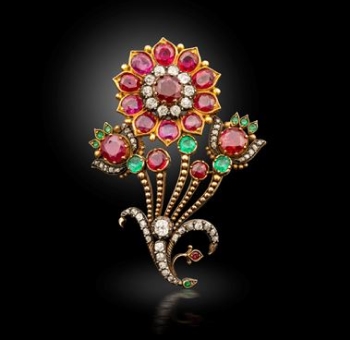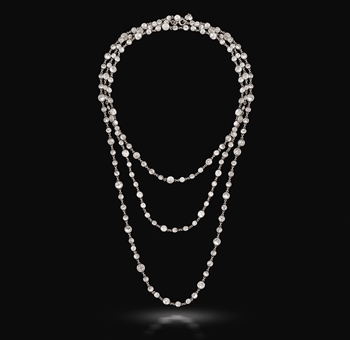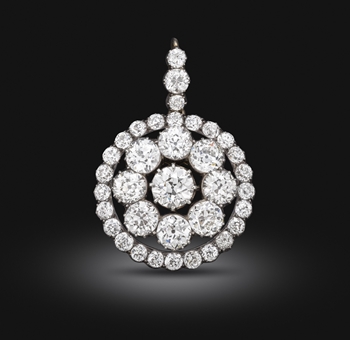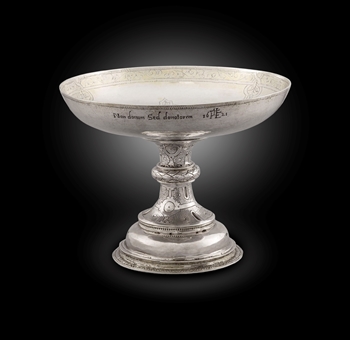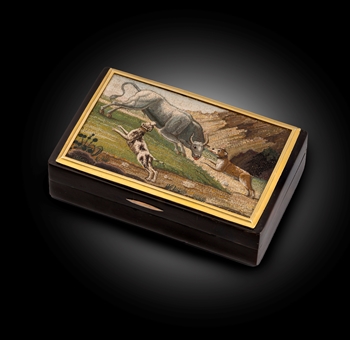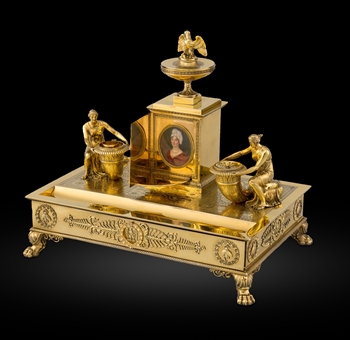 BACK TO LIST
BACK TO LIST
The Art of the Goldsmith at the Coronation.
This year has seen the crowning of King Charles III and once more the art of the goldsmith and jeweller was at the heart of this historic ceremony. Central to this all are the Crown Jewels which are housed in the Tower of London. The Coronation Regalia are sacred and secular objects which symbolise the service and responsibilities of the monarch. The Regalia have played a central role in Coronation Services for hundreds of years and are held in trust by the Monarch on behalf of the nation.
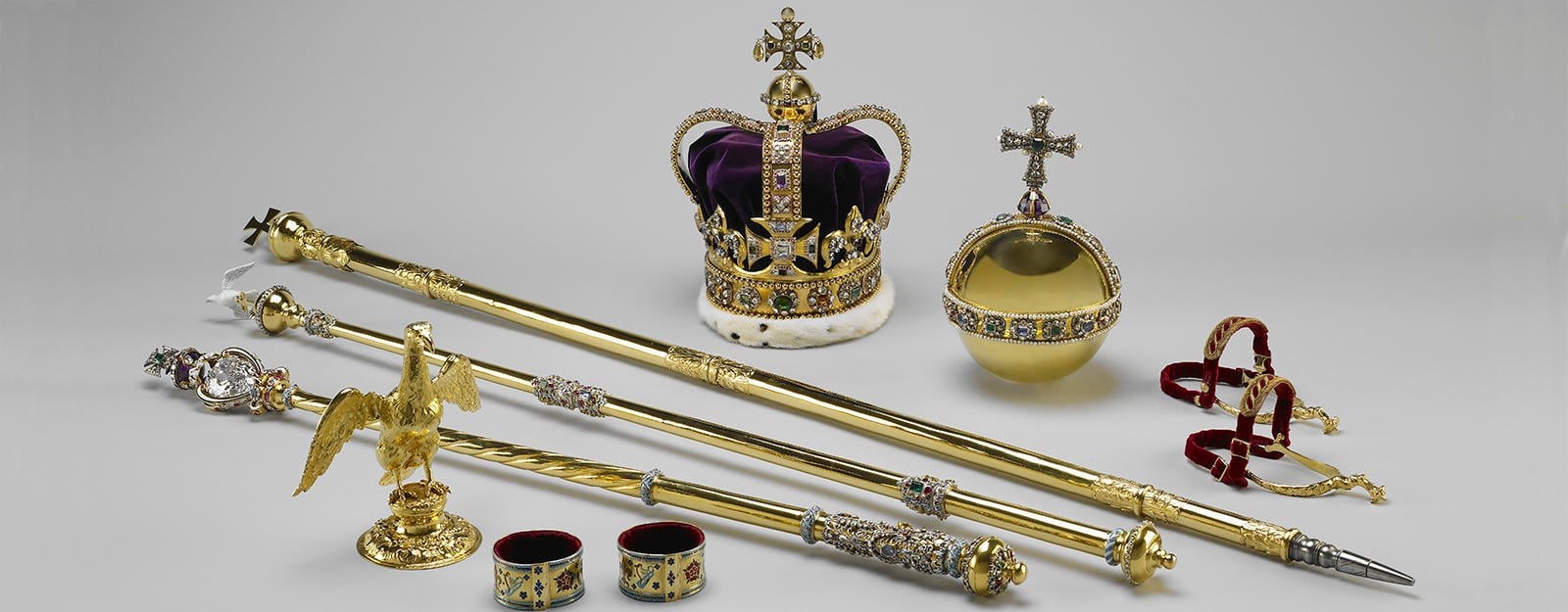
The two maces symbolising Royal authority 1660-1695 are carried at State Opening of Parliament. The Sword of State, symbolising Royal authority has a steel blade with a silver-gilt hilt, enclosed in a wooden scabbard which is covered in velvet. In 1660 and 1678, during the reign of King Charles II, two such swords were made, the elder of which has not survived. The remaining sword has been used at several Coronations and, in 1969, the Investiture of The Prince of Wales. The sword is carried with the point upwards, and the scabbard carries the coat of arms of King William III.
Three further swords were used at the most recent Coronation for the Procession to Westminster Abbey: the Sword of Temporal Justice, signifying the Monarch’s role as Head of the Armed Forces, the Sword of Spiritual Justice, signifying the Monarch as Defender of the Faith, and the Sword of Mercy or Curtana, symbolising the Sovereign’s mercy. The swords were first used at the Coronation of King Charles I in 1626, and the steel blades date back to the sixteenth century, with early seventeenth century gilt-iron hilts, and wire-bound grips. The three swords are carried without their scabbards, with their points up.
The golden St Edward’s Staff, with its steel spike, was created by the Crown Jeweller, Robert Vyner, in 1661. It derives from an earlier staff which was often referred to as the ‘Long Sceptre’ and carried in fifteenth and sixteenth century Coronation processions as a relic of the Royal saint, Edward the Confessor.
The Chrism oil with which The King or Queen is anointed is consecrated in The Church of the Holy Sepulchre in Jerusalem. The oil is contained within the Ampulla, made from gold, and cast in the form of an eagle with outspread wings. The oil is poured through an aperture in the beak. The Ampulla was supplied for the coronation of King Charles II in 1661 by the Crown Jeweller, Robert Vyner, and is based on an earlier, smaller vessel, which in turn was based on a fourteenth-century legend in which the Virgin Mary appeared to St Thomas à Becket and presented him with a golden eagle and a vial of oil for anointing future Kings of England.
The oldest of all the objects used at the coronation is the silver-gilt Coronation Spoon having been first recorded in 1349 among St Edward’s Regalia in Westminster Abbey and is the only piece of Royal goldsmiths’ work to survive from the twelfth century, having possibly been supplied to King Henry II (1133-1189) or King Richard I (1157-1199). It was used to anoint King James I in 1603, and at every subsequent Coronation. In 1649, the Spoon was sold to the Yeoman of King Charles I’s Wardrobe, who returned it for King Charles II’s Coronation in 1661, when small seed pearls were added to the decoration of the handle.
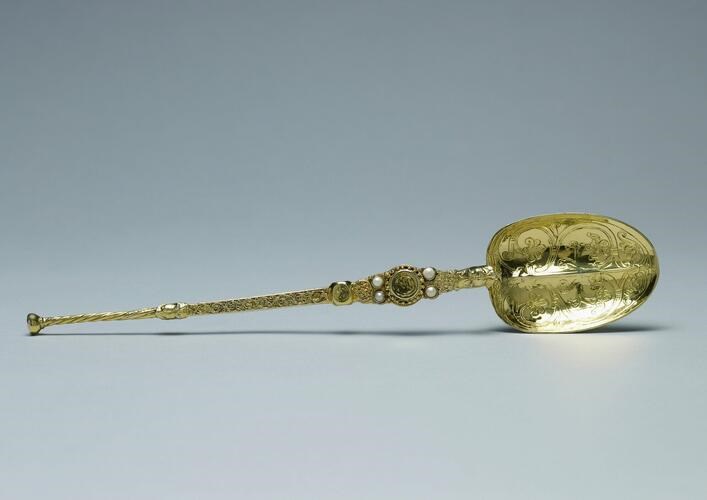
The Spurs were made in 1661 for King Charles II, but the use of spurs at Coronations dates back to King Richard I, the Lionheart, and his Coronation in 1189. The gold, leather and velvet Spurs symbolise knighthood, and they were altered in 1820 for King George IV.
The Sword of Offering was made in 1820, and has a steel blade, mounted in gold, and set with jewels, which form a rose, a thistle, a shamrock, oak leaves, acorns, and lion’s heads. The sword is contained in a gold-covered leather scabbard. It was first used at the Coronation of King George IV.
The two Armills are bracelets made from gold, champlevé and basse-taille enamel, lined in velvet, and are thought to relate to ancient symbols of knighthood and military leadership. They have been referred to during previous Coronations as the 'bracelets of sincerity and wisdom'. The Armills date back to 1661 and have been used at every Coronation from King Charles II’s until King George VI’s in 1937.
A representation of the Sovereign’s power and symbolising the Christian world, the Sovereign’s Orb was made from gold in the seventeenth century and is divided into three sections with bands of jewels, for each of the three continents known in medieval period.
The Sovereign’s Ring is composed of a sapphire with a ruby cross set in diamonds. A symbol of kingly dignity, the ring was made for the Coronation of King William IV in 1831, and all Sovereigns from King Edward VII onwards have used it at their Coronations.
The Sovereign’s Sceptre with Cross represents the sovereign's temporal power and is associated with good governance. It comprises a gold rod, surmounted by an enamelled heart-shaped structure which holds the Cullinan I diamond. The sceptre was created for King Charles II, and the Cullinan I was added in 1901. The Sovereign’s Sceptre with Dove, traditionally known as ‘the Rod of Equity and Mercy', represents the Sovereign’s spiritual role, with the enamelled dove with outspread wings representing the Holy Ghost. It was created by the Crown Jeweller, Robert Vyner in 1661.
In time honoured tradition, this year saw the making of a new special ceremonial cross, The "beautiful and symbolic" Cross of Wales which lead the King's Coronation procession at Westminster Abbey. King Charles III received the cross as a personal gift from Pope Francis to mark his Coronation.
In addition to these spectacular treasures is silver that often goes unnoticed. At the coronation of a monarch the canopies were traditionally carried by the barons of the Cinque Ports as a symbol of the role that they played in defending the king and the country. Arthur Taylor (see Literature) described the barons’ claim was “... to carry over the king in his procession a canopy of cloth of gold or purple silk, with a gilt silver bell at each corner, supported by four staves covered with silver, four barons to every staff; and to carry a like canopy in the same manner over the queen”. By the time this claim was formalised in a charter of Charles II, the number of barons had increased from four to thirty-two. After the ceremony the barons were entitled to keep the canopies, bells and staves as a perquisite of their position, and they were allowed to dine at the table on the king’s right at the coronation banquet. Samuel Pepys described the coronation of Charles II in great detail in his diary entries 22nd and 23rd April 1661 including the King’s entry into Westminster Hall “And the King came in with his crown on, and his sceptre in his hand, under a canopy borne up by six silver staves, carried by Barons of the Cinque Ports, and little bells at every end ... I observed little disorder in all this, but only the King’s footmen had got hold of the canopy and would keep it from the Barons of the Cinque Ports ...”. It was recorded that there was scuffling between the barons and “those who would rob them of their treasures” at the coronation of George IV.
The staves were usually converted into a piece of plate, as in this case. This practice ceased after the coronation of George IV. Examples of the coronation bells of George I, II, III and IV are the collections of the Victoria and Albert Museum and a bell, probably from the coronation of Charles I, was in the Albert Collection (Robin Butler, The Albert Collection, 2004, p. 304, no. 374). A George III basket by Edward Aldridge bears the inscription that it was made with silver from a staff carried by John Dilnot at the coronation of George III (sale, Sotheby’s New York, 19th April 1991, lot 315).
The Cinque Ports: Hastings, Romney, Hythe, Dover and Sandwich were granted privileges by the king in exchange for supplying ships and men to protect England’s vulnerable southern coastline. They had to fulfil this obligation at times of war but they also had to make ships available to the king and his retinue when they wished to travel to the continent. This relationship which probably existed earlier was formalised in a charter of 1260 although the towns were already known as the Cinque Ports by the latter half of the twelfth century. Rye and Winchelsea became part of the group of ports at a later date.

Koopman Rare Art and now at the Victorian and Alber Museum
A Historic & Important James II Cup & Cover
Silver-gilt Unmarked, circa 1685
Height: 5.1in, 13cm
Weight: 16oz 1dwt, 500g
Provenance:
J. Pierpont Morgan and thence by descent
The cup stands on a cast circular gadrooned foot, the lower part of the body is applied with cut card work, the upper part is flat chased with chinoiseries and on one side with a coat of arms within a cartouche with an inscription below and a further inscription within a cartouche on either side, with two beaded handles, the reverse has a scene of figures carrying a canopy. The stepped domed cover also has a gadrooned border and is applied with cut card work, with a spool finial.
The inscription reads:” Hoc obtinui Ex in aug: Iac 2d Et Mar: Ap=23 85” and the motto:” Tria pocula Fero” – “I bear three cups; I obtained this from the coronation of James II and Mary, April 23, 1685”.
The arms are those of Draper for Cresheld or Gawden Draper of Winchelsea.
Cresheld Draper (d. 1693) was amongst those supporting the King’s canopy and Gawden Draper the Queen’s canopy at the coronation of James II. Cresheld Draper of Crayford, Kent was M.P. for Winchelsea from 1678 to 1687. He married Sarah Gauden of Clapham, Surrey in 1665. The inscription on the cup indicates that the cup was made from one of the silver staves used at the coronation which were one of the perquisites of the canopy bearers, the barons of the Cinque Ports, as described below.
The Jewel House Delivery Book (Public Record Office, London LC9/43) contains the entry:
April ye 22th Delivered unto S. Benjamin Bathurst Knt. for theire Majties Coronation Twelve Large Canopy staves, crowned with silver 6 for his Majties & 6 for her Majties
oz dt
Canopy poiz 369: 10: 0
It 8 gilt Bells 4 each Canopy 061: 15: 0
And received by mee
A further entry of 29th April repeats the order with the comment “all which being claims of the Barrons of ye scinqke ports, for their attendance of the coronation. I say recd by mee for ye use of ye said Barrons”.
At the coronation of a monarch the canopies were traditionally carried by the barons of the Cinque Ports as a symbol of the role that they played in defending the king and the country. Arthur Taylor (see Literature) described the barons’ claim was “... to carry over the king in his procession a canopy of cloth of gold or purple silk, with a gilt silver bell at each corner, supported by four staves covered with silver, four barons to every staff; and to carry a like canopy in the same manner over the queen”. By the time this claim was formalised in a charter of Charles II, the number of barons had increased from four to thirty-two. After the ceremony the barons were entitled to keep the canopies, bells and staves as a perquisite of their position, and they were allowed to dine at the table on the king’s right at the coronation banquet. Samuel Pepys described the coronation of Charles II in great detail in his diary entries 22nd and 23rd April 1661 including the King’s entry into Westminster Hall “And the King came in with his crown on, and his sceptre in his hand, under a canopy borne up by six silver staves, carried by Barons of the Cinque Ports, and little bells at every end ... I observed little disorder in all this, but only the King’s footmen had got hold of the canopy, and would keep it from the Barons of the Cinque Ports ...”. It was recorded that there was scuffling between the barons and “those who would rob them of their treasures” at the coronation of George IV.
In his article in Apollo Edward Perry (see Literature) noted that the staves were usually converted into a piece of plate, as in this case. This practice ceased after the coronation of George IV. Examples of the coronation bells of George I, II, III and IV are the collections of the Victoria and Albert Museum and a bell, probably from the coronation of Charles I, was in the Albert Collection (Robin Butler, The Albert Collection, 2004, p. 304, no. 374). A George III basket by Edward Aldridge bears the inscription that it was made with silver from a staff carried by John Dilnot at the coronation of George III (sale, Sotheby’s New York, 19th April 1991, lot 315).
The Cinque Ports: Hastings, Romney, Hythe, Dover and Sandwich were granted privileges by the king in exchange for supplying ships and men to protect England’s vulnerable southern coastline. They had to fulfil this obligation at times of war but they also had to make ships available to the king and his retinue when they wished to travel to the continent. This relationship which probably existed earlier was formalised in a charter of 1260 although the towns were already known as the Cinque Ports by the latter half of the twelfth century. Rye and Winchelsea became part of the group of ports at a later date.
Literature:
Arthur Taylor, The Glory of Regality: An Historical Treatise of the Anointing and Crowning of the Kings and Queens of England, London, 1820
The Cinque Ports, Blackwood’s Edinburgh Magazine, November 1900, vol. 168, p. 711-718
E. Alfred Jones, Illustrated Catalogue of the Collection of Old Plate of J. Pierpoint Morgan, 1908, p. 33, pl. XXIX
Edward Perry, Gift Plate from Westminster Hall Coronation Banquets, Apollo, June 1953, vol. LVII, no. 340, p. 198-200
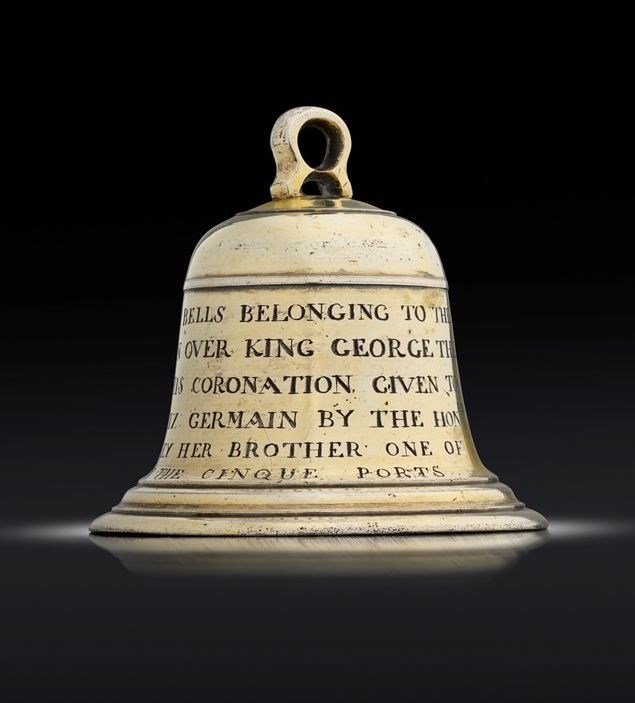
George II Canopy Bell
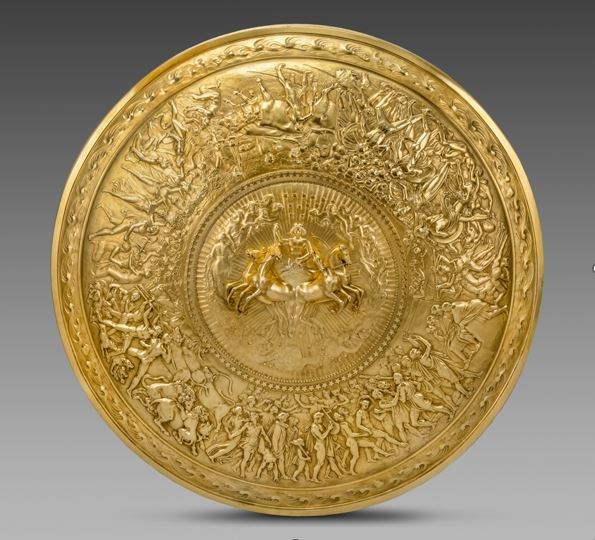
The Koopman Rare Art Collection
The Royal Shield of Achilles
The King of Hanover’s Coronation Shield
Made in London in 1823
by Philip Rundell for Rundell, Bridge & Rundell
Diameter: 35 ¾ in (89.7 cm)
Weight: 723 oz (22,490 g)
This is the shield that sat behind King Charles III for the coronation dinner after the crowning at Westminster. It was created for the coronation of King Geoge IV in 1821.
The spectacular shield of Achilles, the triumphant collaboration between the great firm of Rundell and Bridge and the designer John Flaxman, sits illustriously between history and mythology, destined to inspire generations through the myth of the hero Achilles.
Although John Flaxman – the designer who shaped the Regency in England - had been supplying Rundell and Bridge with drawings since 1805, he modelled only one piece for the firm, the shield of Achilles. Flaxman’s design is an interpretation of the shield given to Achilles by the gods after the demigod lost his armour which he had lent to Patroclus; it having been seized as the spoils of war by Hector.
The Renaissance concept of massive display chargers or shields decorated with scenes celebrating military triumphs had long been out of fashion but was revived by Philip Rundell and John Bridge by 1810, the year in which Flaxman submitted his first designs for this great project. It was to be another seven years before the design was completed to his satisfaction. In 1817 he made the model for the shield himself which was then cast in plaster.
Three or possibly more bronze versions were made and finished by the chaser William Pitts junior and, finally, in 1819 a silver version was made. It was this shield which was then gilded and sold to George IV in 1821 to form the centrepiece for the buffet of plate at his coronation banquet.
Five silver-gilt shields were made in total. The first, mentioned above, which is in the Royal Collection and a further example which was acquired by Frederick Augustus, Duke of York and is now in the collections of the Huntington Library and Art Gallery, San Marino, California; both shields are marked for 1821-22. Two further shields both marked for 1822-23 were sold to Hugh Percy, 3rd Duke of Northumberland in 1822 and to William Lowther, 2nd Earl of Lonsdale in 1823 which is now housed at Anglesey Abbey in the hands of The National Trust. The present shield which is marked for 1823-24 was sold to Ernst Augustus, Duke of Cumberland, and later King of Hanover.
The shields were not made on commission but were a speculative exercise. The present one is of particular importance as it was the only one which remained in the premises of Rundell Bridge and Rundell on display as a magnificent testament to the supreme skills of their craftsmen and designers. The company, who were excellent self-publicists, would have used the shield as an advertisement to maximum advantage.
one of Flaxman's most famous works - a realisation in Neoclassical terms of the shield of Achilles described in Homer's Iliad. The design had been commissioned from Flaxman by Rundell and Bridge; and between 1810 and 1818 Flaxman provided twenty-four drawings and five models. The finished work, executed in silvergilt in 1821, was bought by King George IV and displayed at his coronation banquet.
Homer describes the shield of Achilles as modelled by Hephaestus from bronze, tin, gold and silver; and as showing the heavens, the earth at war, the earth at peace, and the Ocean surrounding all. Flaxman represents the heavens at the centre (Apollo in his chariot surrounded by the moon and stars), and the other scenes as a continuous narrative (not in separate compartments) - incorporating, in the Homeric order, a wedding procession, a town under siege, ploughing, reaping, the vintage with a boy singing, and shepherds defending their flock from lions. Homer implies the use of different metals and enamels, describing the vintage-scene, for example, as wrought in gold but with the grapes in black, the poles in silver and the ditch in blue; but these prescriptions were not followed by Flaxman and Rundell - from considerations of taste, craftsmanship or expense. Flaxman's design may be compared with that of Nicolas Vleughels, published in Volume V of Pope's translation of the Iliad (1720).
The text, the 'Description Of The Shield Of Achilles', presents Homer's ancient Greek text (from Iliad 18:477-607), followed by translations in English, German and French (by Pope, Voss and Bitaubé respectively).
The plates are captioned, and show parts of Flaxman's design, with a quotation from Pope's Homer. The title-page vignette is a portrait of Flaxman.
The original work remains in the British royal collection. A plaster cast (1827) may be seen at the Royal Academy.

The two maces symbolising Royal authority 1660-1695 are carried at State Opening of Parliament. The Sword of State, symbolising Royal authority has a steel blade with a silver-gilt hilt, enclosed in a wooden scabbard which is covered in velvet. In 1660 and 1678, during the reign of King Charles II, two such swords were made, the elder of which has not survived. The remaining sword has been used at several Coronations and, in 1969, the Investiture of The Prince of Wales. The sword is carried with the point upwards, and the scabbard carries the coat of arms of King William III.
Three further swords were used at the most recent Coronation for the Procession to Westminster Abbey: the Sword of Temporal Justice, signifying the Monarch’s role as Head of the Armed Forces, the Sword of Spiritual Justice, signifying the Monarch as Defender of the Faith, and the Sword of Mercy or Curtana, symbolising the Sovereign’s mercy. The swords were first used at the Coronation of King Charles I in 1626, and the steel blades date back to the sixteenth century, with early seventeenth century gilt-iron hilts, and wire-bound grips. The three swords are carried without their scabbards, with their points up.
The golden St Edward’s Staff, with its steel spike, was created by the Crown Jeweller, Robert Vyner, in 1661. It derives from an earlier staff which was often referred to as the ‘Long Sceptre’ and carried in fifteenth and sixteenth century Coronation processions as a relic of the Royal saint, Edward the Confessor.
The Chrism oil with which The King or Queen is anointed is consecrated in The Church of the Holy Sepulchre in Jerusalem. The oil is contained within the Ampulla, made from gold, and cast in the form of an eagle with outspread wings. The oil is poured through an aperture in the beak. The Ampulla was supplied for the coronation of King Charles II in 1661 by the Crown Jeweller, Robert Vyner, and is based on an earlier, smaller vessel, which in turn was based on a fourteenth-century legend in which the Virgin Mary appeared to St Thomas à Becket and presented him with a golden eagle and a vial of oil for anointing future Kings of England.
The oldest of all the objects used at the coronation is the silver-gilt Coronation Spoon having been first recorded in 1349 among St Edward’s Regalia in Westminster Abbey and is the only piece of Royal goldsmiths’ work to survive from the twelfth century, having possibly been supplied to King Henry II (1133-1189) or King Richard I (1157-1199). It was used to anoint King James I in 1603, and at every subsequent Coronation. In 1649, the Spoon was sold to the Yeoman of King Charles I’s Wardrobe, who returned it for King Charles II’s Coronation in 1661, when small seed pearls were added to the decoration of the handle.

The Coronation Spoon
The Spurs were made in 1661 for King Charles II, but the use of spurs at Coronations dates back to King Richard I, the Lionheart, and his Coronation in 1189. The gold, leather and velvet Spurs symbolise knighthood, and they were altered in 1820 for King George IV.
The Sword of Offering was made in 1820, and has a steel blade, mounted in gold, and set with jewels, which form a rose, a thistle, a shamrock, oak leaves, acorns, and lion’s heads. The sword is contained in a gold-covered leather scabbard. It was first used at the Coronation of King George IV.
The two Armills are bracelets made from gold, champlevé and basse-taille enamel, lined in velvet, and are thought to relate to ancient symbols of knighthood and military leadership. They have been referred to during previous Coronations as the 'bracelets of sincerity and wisdom'. The Armills date back to 1661 and have been used at every Coronation from King Charles II’s until King George VI’s in 1937.
A representation of the Sovereign’s power and symbolising the Christian world, the Sovereign’s Orb was made from gold in the seventeenth century and is divided into three sections with bands of jewels, for each of the three continents known in medieval period.
The Sovereign’s Ring is composed of a sapphire with a ruby cross set in diamonds. A symbol of kingly dignity, the ring was made for the Coronation of King William IV in 1831, and all Sovereigns from King Edward VII onwards have used it at their Coronations.
The Sovereign’s Sceptre with Cross represents the sovereign's temporal power and is associated with good governance. It comprises a gold rod, surmounted by an enamelled heart-shaped structure which holds the Cullinan I diamond. The sceptre was created for King Charles II, and the Cullinan I was added in 1901. The Sovereign’s Sceptre with Dove, traditionally known as ‘the Rod of Equity and Mercy', represents the Sovereign’s spiritual role, with the enamelled dove with outspread wings representing the Holy Ghost. It was created by the Crown Jeweller, Robert Vyner in 1661.

St. Edward's Crown
St Edward’s Crown was used to crown His Majesty the King. According to tradition, the crown was made for King Charles II in 1661, as a replacement for the medieval crown which had been melted down in 1649. The original was thought to date back to the eleventh-century royal saint, Edward the Confessor – the last Anglo-Saxon king of England. The crown was commissioned from the Crown Jeweller, Robert Vyner, in 1661. Although it is not an exact replica of the medieval design, it follows the original in having four crosses-pattée and four fleurs-de-lis, and two arches. The crown is topped with an orb and a cross, symbolising the Christian world, and is made up of a solid gold frame set with rubies, amethysts, sapphires, garnet, topazes, and tourmalines. The crown has a velvet cap with an ermine band. St Edward’s Crown was worn by Queen Elizabeth II at the Coronation in 1953.
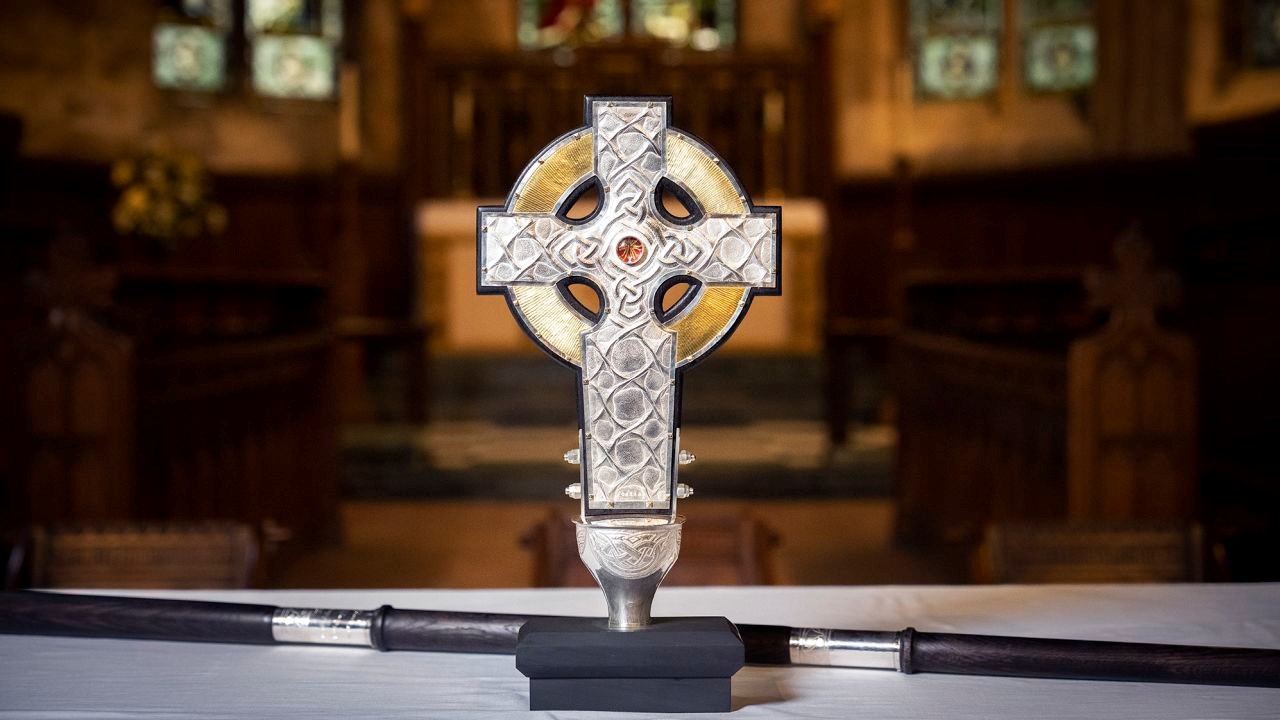

The Cross of Wales
In time honoured tradition, this year saw the making of a new special ceremonial cross, The "beautiful and symbolic" Cross of Wales which lead the King's Coronation procession at Westminster Abbey. King Charles III received the cross as a personal gift from Pope Francis to mark his Coronation.
In addition to these spectacular treasures is silver that often goes unnoticed. At the coronation of a monarch the canopies were traditionally carried by the barons of the Cinque Ports as a symbol of the role that they played in defending the king and the country. Arthur Taylor (see Literature) described the barons’ claim was “... to carry over the king in his procession a canopy of cloth of gold or purple silk, with a gilt silver bell at each corner, supported by four staves covered with silver, four barons to every staff; and to carry a like canopy in the same manner over the queen”. By the time this claim was formalised in a charter of Charles II, the number of barons had increased from four to thirty-two. After the ceremony the barons were entitled to keep the canopies, bells and staves as a perquisite of their position, and they were allowed to dine at the table on the king’s right at the coronation banquet. Samuel Pepys described the coronation of Charles II in great detail in his diary entries 22nd and 23rd April 1661 including the King’s entry into Westminster Hall “And the King came in with his crown on, and his sceptre in his hand, under a canopy borne up by six silver staves, carried by Barons of the Cinque Ports, and little bells at every end ... I observed little disorder in all this, but only the King’s footmen had got hold of the canopy and would keep it from the Barons of the Cinque Ports ...”. It was recorded that there was scuffling between the barons and “those who would rob them of their treasures” at the coronation of George IV.
The staves were usually converted into a piece of plate, as in this case. This practice ceased after the coronation of George IV. Examples of the coronation bells of George I, II, III and IV are the collections of the Victoria and Albert Museum and a bell, probably from the coronation of Charles I, was in the Albert Collection (Robin Butler, The Albert Collection, 2004, p. 304, no. 374). A George III basket by Edward Aldridge bears the inscription that it was made with silver from a staff carried by John Dilnot at the coronation of George III (sale, Sotheby’s New York, 19th April 1991, lot 315).
The Cinque Ports: Hastings, Romney, Hythe, Dover and Sandwich were granted privileges by the king in exchange for supplying ships and men to protect England’s vulnerable southern coastline. They had to fulfil this obligation at times of war but they also had to make ships available to the king and his retinue when they wished to travel to the continent. This relationship which probably existed earlier was formalised in a charter of 1260 although the towns were already known as the Cinque Ports by the latter half of the twelfth century. Rye and Winchelsea became part of the group of ports at a later date.

Koopman Rare Art and now at the Victorian and Alber Museum
A Historic & Important James II Cup & Cover
Silver-gilt Unmarked, circa 1685
Height: 5.1in, 13cm
Weight: 16oz 1dwt, 500g
Provenance:
J. Pierpont Morgan and thence by descent
The cup stands on a cast circular gadrooned foot, the lower part of the body is applied with cut card work, the upper part is flat chased with chinoiseries and on one side with a coat of arms within a cartouche with an inscription below and a further inscription within a cartouche on either side, with two beaded handles, the reverse has a scene of figures carrying a canopy. The stepped domed cover also has a gadrooned border and is applied with cut card work, with a spool finial.
The inscription reads:” Hoc obtinui Ex in aug: Iac 2d Et Mar: Ap=23 85” and the motto:” Tria pocula Fero” – “I bear three cups; I obtained this from the coronation of James II and Mary, April 23, 1685”.
The arms are those of Draper for Cresheld or Gawden Draper of Winchelsea.
Cresheld Draper (d. 1693) was amongst those supporting the King’s canopy and Gawden Draper the Queen’s canopy at the coronation of James II. Cresheld Draper of Crayford, Kent was M.P. for Winchelsea from 1678 to 1687. He married Sarah Gauden of Clapham, Surrey in 1665. The inscription on the cup indicates that the cup was made from one of the silver staves used at the coronation which were one of the perquisites of the canopy bearers, the barons of the Cinque Ports, as described below.
The Jewel House Delivery Book (Public Record Office, London LC9/43) contains the entry:
April ye 22th Delivered unto S. Benjamin Bathurst Knt. for theire Majties Coronation Twelve Large Canopy staves, crowned with silver 6 for his Majties & 6 for her Majties
oz dt
Canopy poiz 369: 10: 0
It 8 gilt Bells 4 each Canopy 061: 15: 0
And received by mee
A further entry of 29th April repeats the order with the comment “all which being claims of the Barrons of ye scinqke ports, for their attendance of the coronation. I say recd by mee for ye use of ye said Barrons”.
At the coronation of a monarch the canopies were traditionally carried by the barons of the Cinque Ports as a symbol of the role that they played in defending the king and the country. Arthur Taylor (see Literature) described the barons’ claim was “... to carry over the king in his procession a canopy of cloth of gold or purple silk, with a gilt silver bell at each corner, supported by four staves covered with silver, four barons to every staff; and to carry a like canopy in the same manner over the queen”. By the time this claim was formalised in a charter of Charles II, the number of barons had increased from four to thirty-two. After the ceremony the barons were entitled to keep the canopies, bells and staves as a perquisite of their position, and they were allowed to dine at the table on the king’s right at the coronation banquet. Samuel Pepys described the coronation of Charles II in great detail in his diary entries 22nd and 23rd April 1661 including the King’s entry into Westminster Hall “And the King came in with his crown on, and his sceptre in his hand, under a canopy borne up by six silver staves, carried by Barons of the Cinque Ports, and little bells at every end ... I observed little disorder in all this, but only the King’s footmen had got hold of the canopy, and would keep it from the Barons of the Cinque Ports ...”. It was recorded that there was scuffling between the barons and “those who would rob them of their treasures” at the coronation of George IV.
In his article in Apollo Edward Perry (see Literature) noted that the staves were usually converted into a piece of plate, as in this case. This practice ceased after the coronation of George IV. Examples of the coronation bells of George I, II, III and IV are the collections of the Victoria and Albert Museum and a bell, probably from the coronation of Charles I, was in the Albert Collection (Robin Butler, The Albert Collection, 2004, p. 304, no. 374). A George III basket by Edward Aldridge bears the inscription that it was made with silver from a staff carried by John Dilnot at the coronation of George III (sale, Sotheby’s New York, 19th April 1991, lot 315).
The Cinque Ports: Hastings, Romney, Hythe, Dover and Sandwich were granted privileges by the king in exchange for supplying ships and men to protect England’s vulnerable southern coastline. They had to fulfil this obligation at times of war but they also had to make ships available to the king and his retinue when they wished to travel to the continent. This relationship which probably existed earlier was formalised in a charter of 1260 although the towns were already known as the Cinque Ports by the latter half of the twelfth century. Rye and Winchelsea became part of the group of ports at a later date.
Literature:
Arthur Taylor, The Glory of Regality: An Historical Treatise of the Anointing and Crowning of the Kings and Queens of England, London, 1820
The Cinque Ports, Blackwood’s Edinburgh Magazine, November 1900, vol. 168, p. 711-718
E. Alfred Jones, Illustrated Catalogue of the Collection of Old Plate of J. Pierpoint Morgan, 1908, p. 33, pl. XXIX
Edward Perry, Gift Plate from Westminster Hall Coronation Banquets, Apollo, June 1953, vol. LVII, no. 340, p. 198-200

George II Canopy Bell
A rare silver-gilt George II coronation canopy bell
by Francis Garthorne
Made London circa 1727
height 7.1cm, approx. weight 7.3oz.
Of conventional form, with a loop attachment and reeded borders, inscribed 'ONE OF THE BELLS BELONGING TO THE CANOPY BORN OVER KING GEORGE THE SECOND AT HIS CORONATION GIVEN TO THE LADY ELIZ GERMAIN BY THE HON. GEORGE BERKELEY HER BROTHER ONE OF THE BARONS OF THE CINQUE PORTS',
Provenance:
The Hon. George Berkeley, d.1746
to Lady Elizabeth Germain, d.1769
by family descent to Col Sir Joseph Weld, Lulworth, Dorset, d.1992
by family descent to the present owner.
Illustrated in Clayton, M., The Collectors Dictionary of the Silver and Gold of Great Britain and North America, Woodbridge, 1971, p. 34, fig. 33b.
A small group of coronation bells survive today, of which the earliest example is thought to have been used at the coronation of King Charles II in 1660. Two coronation bells were bequeathed to the nation by the Countess of Waldegrave. The first is by Francis Garthorne, the maker of the present bell, and is hallmarked for 1714/15. However, it is engraved 'George 2nd 1727'. It has been suggested that it was first used at the coronation of King George I in 1714 and re-used at the coronation of his son in 1727.
At the coronation of King George II, held on the 11th October 1727, the Canopy of State was carried by the members of parliament of the Cinque Ports. In his position as M.P. for Dover, the Hon. George Berkeley was appointed as a canopy bearer. This right was established during the reign of King Edward I as cited by Mantel, T., in Coronation Ceremonies and Customs, relative to the Barons of the Cinque Ports as Supports of the Canopy, Dover, 1820.
Francis Garthorne:
He is described as a Free Girdler in the entry of his hallmark. The Goldsmiths Hall records prior to 1694 have not survived but he is entered in a April 1697 as a largeworker on commencement of the register. Address: Sweeting Lane, he iso ne of the petitioners against 'aliens or foreigners in 1697 and again as 'working goldsmith' to that complaining of the competition of 'necessitous strangers in 1711. . After the return to the sterling standard in 1720 he reverts back to his pre-1697 mark on the evidence of its similarity to that described to George Garthorne for the same period. He appears in the list of Subordinate Goldsmiths to the Queen and King, 1702-1723.
by Francis Garthorne
Made London circa 1727
height 7.1cm, approx. weight 7.3oz.
Of conventional form, with a loop attachment and reeded borders, inscribed 'ONE OF THE BELLS BELONGING TO THE CANOPY BORN OVER KING GEORGE THE SECOND AT HIS CORONATION GIVEN TO THE LADY ELIZ GERMAIN BY THE HON. GEORGE BERKELEY HER BROTHER ONE OF THE BARONS OF THE CINQUE PORTS',
Provenance:
The Hon. George Berkeley, d.1746
to Lady Elizabeth Germain, d.1769
by family descent to Col Sir Joseph Weld, Lulworth, Dorset, d.1992
by family descent to the present owner.
Illustrated in Clayton, M., The Collectors Dictionary of the Silver and Gold of Great Britain and North America, Woodbridge, 1971, p. 34, fig. 33b.
A small group of coronation bells survive today, of which the earliest example is thought to have been used at the coronation of King Charles II in 1660. Two coronation bells were bequeathed to the nation by the Countess of Waldegrave. The first is by Francis Garthorne, the maker of the present bell, and is hallmarked for 1714/15. However, it is engraved 'George 2nd 1727'. It has been suggested that it was first used at the coronation of King George I in 1714 and re-used at the coronation of his son in 1727.
At the coronation of King George II, held on the 11th October 1727, the Canopy of State was carried by the members of parliament of the Cinque Ports. In his position as M.P. for Dover, the Hon. George Berkeley was appointed as a canopy bearer. This right was established during the reign of King Edward I as cited by Mantel, T., in Coronation Ceremonies and Customs, relative to the Barons of the Cinque Ports as Supports of the Canopy, Dover, 1820.
Francis Garthorne:
He is described as a Free Girdler in the entry of his hallmark. The Goldsmiths Hall records prior to 1694 have not survived but he is entered in a April 1697 as a largeworker on commencement of the register. Address: Sweeting Lane, he iso ne of the petitioners against 'aliens or foreigners in 1697 and again as 'working goldsmith' to that complaining of the competition of 'necessitous strangers in 1711. . After the return to the sterling standard in 1720 he reverts back to his pre-1697 mark on the evidence of its similarity to that described to George Garthorne for the same period. He appears in the list of Subordinate Goldsmiths to the Queen and King, 1702-1723.

The Koopman Rare Art Collection
The Royal Shield of Achilles
The King of Hanover’s Coronation Shield
Made in London in 1823
by Philip Rundell for Rundell, Bridge & Rundell
Diameter: 35 ¾ in (89.7 cm)
Weight: 723 oz (22,490 g)
This is the shield that sat behind King Charles III for the coronation dinner after the crowning at Westminster. It was created for the coronation of King Geoge IV in 1821.
The spectacular shield of Achilles, the triumphant collaboration between the great firm of Rundell and Bridge and the designer John Flaxman, sits illustriously between history and mythology, destined to inspire generations through the myth of the hero Achilles.
Although John Flaxman – the designer who shaped the Regency in England - had been supplying Rundell and Bridge with drawings since 1805, he modelled only one piece for the firm, the shield of Achilles. Flaxman’s design is an interpretation of the shield given to Achilles by the gods after the demigod lost his armour which he had lent to Patroclus; it having been seized as the spoils of war by Hector.
The Renaissance concept of massive display chargers or shields decorated with scenes celebrating military triumphs had long been out of fashion but was revived by Philip Rundell and John Bridge by 1810, the year in which Flaxman submitted his first designs for this great project. It was to be another seven years before the design was completed to his satisfaction. In 1817 he made the model for the shield himself which was then cast in plaster.
Three or possibly more bronze versions were made and finished by the chaser William Pitts junior and, finally, in 1819 a silver version was made. It was this shield which was then gilded and sold to George IV in 1821 to form the centrepiece for the buffet of plate at his coronation banquet.
Five silver-gilt shields were made in total. The first, mentioned above, which is in the Royal Collection and a further example which was acquired by Frederick Augustus, Duke of York and is now in the collections of the Huntington Library and Art Gallery, San Marino, California; both shields are marked for 1821-22. Two further shields both marked for 1822-23 were sold to Hugh Percy, 3rd Duke of Northumberland in 1822 and to William Lowther, 2nd Earl of Lonsdale in 1823 which is now housed at Anglesey Abbey in the hands of The National Trust. The present shield which is marked for 1823-24 was sold to Ernst Augustus, Duke of Cumberland, and later King of Hanover.
The shields were not made on commission but were a speculative exercise. The present one is of particular importance as it was the only one which remained in the premises of Rundell Bridge and Rundell on display as a magnificent testament to the supreme skills of their craftsmen and designers. The company, who were excellent self-publicists, would have used the shield as an advertisement to maximum advantage.
one of Flaxman's most famous works - a realisation in Neoclassical terms of the shield of Achilles described in Homer's Iliad. The design had been commissioned from Flaxman by Rundell and Bridge; and between 1810 and 1818 Flaxman provided twenty-four drawings and five models. The finished work, executed in silvergilt in 1821, was bought by King George IV and displayed at his coronation banquet.
Homer describes the shield of Achilles as modelled by Hephaestus from bronze, tin, gold and silver; and as showing the heavens, the earth at war, the earth at peace, and the Ocean surrounding all. Flaxman represents the heavens at the centre (Apollo in his chariot surrounded by the moon and stars), and the other scenes as a continuous narrative (not in separate compartments) - incorporating, in the Homeric order, a wedding procession, a town under siege, ploughing, reaping, the vintage with a boy singing, and shepherds defending their flock from lions. Homer implies the use of different metals and enamels, describing the vintage-scene, for example, as wrought in gold but with the grapes in black, the poles in silver and the ditch in blue; but these prescriptions were not followed by Flaxman and Rundell - from considerations of taste, craftsmanship or expense. Flaxman's design may be compared with that of Nicolas Vleughels, published in Volume V of Pope's translation of the Iliad (1720).
The text, the 'Description Of The Shield Of Achilles', presents Homer's ancient Greek text (from Iliad 18:477-607), followed by translations in English, German and French (by Pope, Voss and Bitaubé respectively).
The plates are captioned, and show parts of Flaxman's design, with a quotation from Pope's Homer. The title-page vignette is a portrait of Flaxman.
The original work remains in the British royal collection. A plaster cast (1827) may be seen at the Royal Academy.




